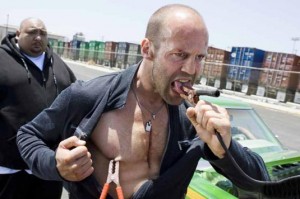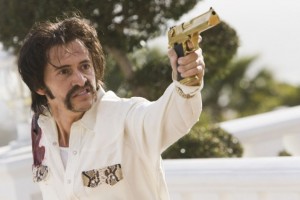Crank: High Voltage
 Is it possible to be consciously and intentionally out of control? If a Nascar driver were swerving and spinning for hundreds of laps and ended up winning the race, could he do the same thing again on purpose? Should you be given credit for a lucky accident? Donnie Darko might be the answer to those questions, especially as writer/director Richard Kelly stumbled upon a confused jumble of style and mystery, before losing control in the last act. His inept storytelling was determined to be depth and genius by the frat boys and high school students who might envision that their own screw-ups might be viewed in such a favorable light as well. The proof is in the fact that Kelly’s director’s cut of Donnie Darko makes all the wrong choices, clearing up what he really thought, revealing that the emperor couldn’t even afford to pay for his dry cleaning. As if to solidify his status as a no-hit wonder, Kelly’s second film Southland Tales, a serious satirical action-musical about the end of the world, is an incomprehensible, overlong, laughably murky mess, exacerbated by casting choices that are suited to enchant an 8th grader (Sarah Michelle Gellar, Justin Timberlake, Mandy Moore, Seann William Scott, and Dwayne “The Rock” Johnson).
Is it possible to be consciously and intentionally out of control? If a Nascar driver were swerving and spinning for hundreds of laps and ended up winning the race, could he do the same thing again on purpose? Should you be given credit for a lucky accident? Donnie Darko might be the answer to those questions, especially as writer/director Richard Kelly stumbled upon a confused jumble of style and mystery, before losing control in the last act. His inept storytelling was determined to be depth and genius by the frat boys and high school students who might envision that their own screw-ups might be viewed in such a favorable light as well. The proof is in the fact that Kelly’s director’s cut of Donnie Darko makes all the wrong choices, clearing up what he really thought, revealing that the emperor couldn’t even afford to pay for his dry cleaning. As if to solidify his status as a no-hit wonder, Kelly’s second film Southland Tales, a serious satirical action-musical about the end of the world, is an incomprehensible, overlong, laughably murky mess, exacerbated by casting choices that are suited to enchant an 8th grader (Sarah Michelle Gellar, Justin Timberlake, Mandy Moore, Seann William Scott, and Dwayne “The Rock” Johnson).
 Mark Neveldine and Brian Taylor had far less lofty ambitions with Crank: High Voltage, their sequel to the manic, ridiculous, and wonderfully silly and over-the-top Crank. The first film had such a tasteless energy, it was a terrible movie that made us aware that it knew that, and it ran with the crass, short-attention span, amoral style, complete with constant ads for Google Maps and Red Bull. Everything about Crank is so willfully stupid that the jittery camerawork and rapid-fire editing are not a detriment, but simply a way to squeeze as much idiocy into as short a running time as possible. Chev Chelios (Jason Statham) was going to find out who poisoned him, forcing him to constantly search for adrenaline rushes to stay alive, whether it be snorting coke off a urine-soaked bathroom floor, charging himself with a defibrillator, or having sex in the middle of Chinatown amidst hundreds of onlookers.
Mark Neveldine and Brian Taylor had far less lofty ambitions with Crank: High Voltage, their sequel to the manic, ridiculous, and wonderfully silly and over-the-top Crank. The first film had such a tasteless energy, it was a terrible movie that made us aware that it knew that, and it ran with the crass, short-attention span, amoral style, complete with constant ads for Google Maps and Red Bull. Everything about Crank is so willfully stupid that the jittery camerawork and rapid-fire editing are not a detriment, but simply a way to squeeze as much idiocy into as short a running time as possible. Chev Chelios (Jason Statham) was going to find out who poisoned him, forcing him to constantly search for adrenaline rushes to stay alive, whether it be snorting coke off a urine-soaked bathroom floor, charging himself with a defibrillator, or having sex in the middle of Chinatown amidst hundreds of onlookers.
But Neveldine and Taylor didn’t know how to leave the movie alone, trying to take credit for what worked in Crank, and a totally unnecessary director’s cut was released in Germany, integrating literal video game footage of Chev stomping around Los Angeles (Uwe Boll would be proud). By telling us that Crank is not a movie but a video game with power-ups, cheats, and extra lives removes any connection we might have to the film, because it eliminates any consequences to Chev’s actions. While the conclusion of Crank, where, having fallen hundreds of feet into a car and then the pavement, Chev blinks at us to signal that he was still alive, was originally funny, as a sort-of exclamation point on Chelios’ indestructibility, it loses the humor once we think it isn’t real (within the context of the nonsense).
 Copping to how unrealistic your movie is by excusing it, rather than running with it, is a mistake that Taylor and Neveldine have never recovered from. The fact that the funniest moment in Crank: High Voltage (which opens with more video game footage) is a transition from a standard fistfight to Chelios and his foe fighting in slow motion crushing small-scale models underfoot, as if they were Godzilla and King Kong, is a surprise. The scene goes on too long, but it is one of the amusing respites from 90 mostly middling minutes.
Copping to how unrealistic your movie is by excusing it, rather than running with it, is a mistake that Taylor and Neveldine have never recovered from. The fact that the funniest moment in Crank: High Voltage (which opens with more video game footage) is a transition from a standard fistfight to Chelios and his foe fighting in slow motion crushing small-scale models underfoot, as if they were Godzilla and King Kong, is a surprise. The scene goes on too long, but it is one of the amusing respites from 90 mostly middling minutes.
The problem with Crank: High Voltage is that it seems forced and padded. It is neither terrible or tacky enough to be funny or smart enough to be a legit action movie. There are virtually no creative variations on the original concept (except for the scene where he tries to rub up against an old lady to produce friction); Chev has to keep his artificial heart running with excessive amounts of electricity, but it only requires him looking around the immediate area to find the most obvious solution, a power line, a taser, an electrified dog collar, etc. The repeat of the public sex gag (featuring Amy Smart again playing Statham’s girlfriend, whether you want to refer to her performance as brave or embarrassing is purely subjective), this time at a race track, is gratuitous and desperate, even by the obviously lax standards of the Crank series.
 The excess of Crank: High Voltage should be what makes it amusing, but all the racism, homophobia, and heavy misogyny that was part and parcel in the first film, playing as deliberately offensive subtext, is laid bare in the sequel. There’s not enough going on in Crank: High Voltage to be distracted from thoughts, something that should never have been on the agenda, such as, “boy, these guys really hate women,” or “how many times are they going to play the whole long-lost brother game?” Neveldine and Taylor don’t have enough ideas to justify more than ½ an hour of Crank: High Voltage, and so characters like Bai Ling’s clingy and pathetic hooker, David Carradine as an ancient Chinese gangster, or a bewildering extended flashback to Chev as a juvenile delinquent on a talk show, barely have a worthy set-up, let alone a punchline.
The excess of Crank: High Voltage should be what makes it amusing, but all the racism, homophobia, and heavy misogyny that was part and parcel in the first film, playing as deliberately offensive subtext, is laid bare in the sequel. There’s not enough going on in Crank: High Voltage to be distracted from thoughts, something that should never have been on the agenda, such as, “boy, these guys really hate women,” or “how many times are they going to play the whole long-lost brother game?” Neveldine and Taylor don’t have enough ideas to justify more than ½ an hour of Crank: High Voltage, and so characters like Bai Ling’s clingy and pathetic hooker, David Carradine as an ancient Chinese gangster, or a bewildering extended flashback to Chev as a juvenile delinquent on a talk show, barely have a worthy set-up, let alone a punchline.
 And maybe that’s for the best, because it appears that when Neveldine and Taylor know what they’re doing, the movie falls apart, as do their attempts to embrace low-brow exploitation. A shoot-out in a strip club isn’t just hard to follow, it’s boring, and the exploding boob implant shot is poorly done, and can’t even muster being offensive. The action scenes in Crank: High Voltage are repetitive and uninteresting, as if they’ve been planned to the point of squeezing out any accidental ingenuity. There’s nothing even remotely as ingenious as the scene in Crank where Chev makes a phone call to Amy Smart, as he’s plummeting to his death. Even when Neveldine and Taylor try to piss us off with casual racism, such as when Chelios asks a gang member for directions by saying “Hey, Menudo,” the line just dies; The guys who made the first Crank, whether they knew it or not, would have had the panache to incorporate the race-baiting idea into a worthy conflict, not just a scattered bit of nothing. I can already picture Ricky Martin and the rest of Menudo coming out of the woodworks, being chased by Chev, as he tries to rub up against their half-shirts, leg-warmers, and excessive hairspray, trying to produce friction.
And maybe that’s for the best, because it appears that when Neveldine and Taylor know what they’re doing, the movie falls apart, as do their attempts to embrace low-brow exploitation. A shoot-out in a strip club isn’t just hard to follow, it’s boring, and the exploding boob implant shot is poorly done, and can’t even muster being offensive. The action scenes in Crank: High Voltage are repetitive and uninteresting, as if they’ve been planned to the point of squeezing out any accidental ingenuity. There’s nothing even remotely as ingenious as the scene in Crank where Chev makes a phone call to Amy Smart, as he’s plummeting to his death. Even when Neveldine and Taylor try to piss us off with casual racism, such as when Chelios asks a gang member for directions by saying “Hey, Menudo,” the line just dies; The guys who made the first Crank, whether they knew it or not, would have had the panache to incorporate the race-baiting idea into a worthy conflict, not just a scattered bit of nothing. I can already picture Ricky Martin and the rest of Menudo coming out of the woodworks, being chased by Chev, as he tries to rub up against their half-shirts, leg-warmers, and excessive hairspray, trying to produce friction.



